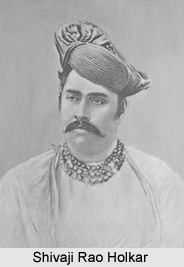 History of Indore district deals with the rule of the kings of the Holkar dynasty. The district of Indore is situated on one of India`s most primitive pilgrimage routes from Mahakaal at Ujjain on Shipra River to Omkareshwar on the Narmada River and onwards to Rameshwaram. It was on the way of the Marathas of Deccan to North India. These Maratha guerrilla warriors were in constant battle with the rulers of Mughal Dynasty. Their army transit camps at Indore attracted the local Zamindars who, drawn by the promise of lucrative trade, settled in the villages on the confluence of the Khan and Sarasvati rivers, thereby laying the foundation of this commercial centre in 1715. In 1741, Indreshwar temple was erected in the town, from which the district derives its name, Indore.
History of Indore district deals with the rule of the kings of the Holkar dynasty. The district of Indore is situated on one of India`s most primitive pilgrimage routes from Mahakaal at Ujjain on Shipra River to Omkareshwar on the Narmada River and onwards to Rameshwaram. It was on the way of the Marathas of Deccan to North India. These Maratha guerrilla warriors were in constant battle with the rulers of Mughal Dynasty. Their army transit camps at Indore attracted the local Zamindars who, drawn by the promise of lucrative trade, settled in the villages on the confluence of the Khan and Sarasvati rivers, thereby laying the foundation of this commercial centre in 1715. In 1741, Indreshwar temple was erected in the town, from which the district derives its name, Indore.
The trade centre grew rapidly under the Holkar dynasty (1733-1818). The remains of their two-century-old palace still stand in the main square called Rajwada. The city became the capital of the princely state of Indore in 1818 after the British forces under Sir John Malcolm defeated the Holkars led by Rani Krishnabai Holkar at Mahidpur. She signed the treaty of Mandsaur by which the control of Indore went into the hand of the British East India Company. Between 1948 and 1956, Indore served as the summer capital of the former Madhya Bharat state.
Holkar, the family name of the Maratha rulers of Indore, was adopted as a dynastic title. The family was of peasant origin and of shepherd caste. It is said that they migrated from the Mathura district of Uttar Pradesh to the village of Hol about 65 kilometres from Pune in Maharashtra. The name of this village coupled with the Maratha terminal Kar, provided a surname used by all members of the family. In the year 1818, Holkars became a part of British Empire in India, when the British East India Company annexed the princely state of Indore. Then Indore became the official capital of the Holkar kingdom with a British Resident stationed at Indore. Indore was a participant in the Sepoy Mutiny 1857. At eight o`clock on 1st July 1857, the mutiny began. Thirty-nine English military men were killed and the Chief Resident managed to escape. The British retook Indore after a few months and Saadat Khan, who led the mutiny, was tried and sentenced to death. The last four Holkar rulers are often called the makers of modern Indore and they include Tukoji Rao II, Shivaji Rao Holkar, Tukoji Rao III and Yeshwant Rao Holkar.
Till 1947, when India became independent, Indore was a princely state. After independence, Indore state joined the dominion of India along with hundreds of other princely states. The Holkar Dynasty, as rulers of Indore formally ended when former Prime Minister Indira Gandhi abolished the state pension of all the ex-ruler families. Even now, the Holika (firewood burnt on the eve of Holi) in front of "Rajbada" is lit by members of Holkar family in the district of Indore in Madhya Pradesh.






